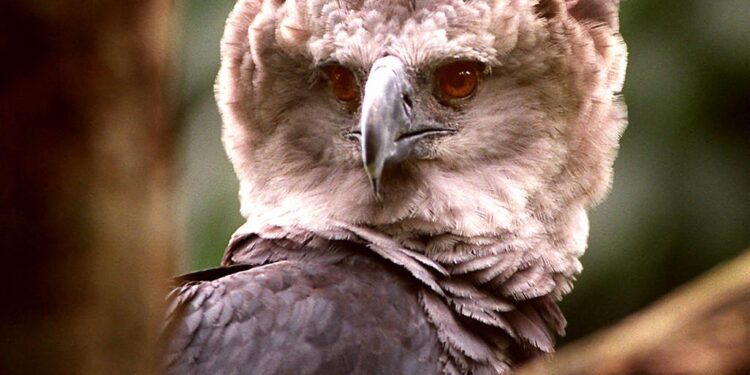A Harpy Eagle in the Panamania Rain Forest. The Harpy is the most powerful bird of prey in the world … [+] that needs large tracts of undisturbed lowland tropical forest . The raptor feeds on sloths and mokeys. It’s range used to be from Mexico to Ecuador but now can be found mostly only in Panama, Colombia, Venezuela and Guyana. This is a large female that has a seven foot wingspan and weighs about 16 pounds. (photo by Tim Chapman)
Getty Images
During my eight-day visit to Panama in September, the Minister of Environment, Juan Carlos Navarro, described his country as a “little paradise” where the continents of North and South America meet. Panama is a 480-mile-long strip of land, known as the isthmus, that extends from Costa Rica to Colombia, separating the Atlantic and Pacific Oceans.
Panama is carbon-negative because its rainforests absorb more CO2 than its economy emits. Despite its efforts to preserve its trees, it has suffered from the effects of climate change. In 2023, the country experienced a drought that decreased the water levels of the Panama Canal, resulting in a $1 billion revenue loss. Scientists worldwide believe that the use of fossil fuels is worsening the greenhouse effect, leading to intense warming, extreme climate events, and longer dry spells.
“Even though we are victims of climate change, we have an ambitious climate agenda,” Minister Navarro told me. “We are losing the planet, and won’t achieve the goals of the Paris Agreement”—to limit temperature increases to 1.5 degrees Celsius by 2050. “The only way to stop climate change is to involve the private and philanthropic sectors to deploy clean energy, electric mobility, conservation, and protection initiatives in Panama. There are tons of investments that private companies can make to generate financial returns.”
For example, Navarro founded Panama’s Solar Energy Association, which has 62 companies building solar farms and investing in electric vehicle chargers. Panama is considered a developed country, driven mainly by the Panama Canal, which earns about $6 billion yearly and attracts companies such as Maersk and Proctor & Gamble. The Panama Canal Authority pays the government about $2.5 yearly.
The Panama Canal is a conduit for 6% of the global maritime traffic. It is amid Panama’s rainforests covering 68% of its land or nearly 12.7 million acres—natural CO2 vacuums. Roughly 32 ships pass through each day, taking 8-10 hours. It’s one of the seven “Wonders of the World.”
The country’s gross domestic product is $76.5 billion, growing by 4% to 5% yearly. It is based on banking, insurance, container ports, medical, and tourism. Renewable electricity, mainly hydro, accounts for 80% of its electricity portfolio.
Without ample rainfall, the canal suffers the consequences. The forests act as a sponge, feeding two lakes that fill the locks and allow ships to pass through. Panama safeguards its trees, home to indigenous peoples as well as biodiversity and precious wildlife. I visited a few of the islands and saw various kinds of monkeys and bats.
Moreover, Panama just signed the High Seas Treaty to protect the ocean and its biodiversity. Roughly 60 other nations endorsed it.
“This is a perfect example of sustainable development,” says Navarro, referring to the Panama Canal and the country’s efforts to save trees and biodiversity. “Without this, the economies of the United States and Asia would suffer” because the supply chains would get cut off. “This would be an economic catastrophe.”
But Panama Is A Victim Of Climate Change
Panama’s Environment Minister Juan Carlos Navarro
Wikipedia
Climate change risks Panama, its natural wonders, and the global community. I spoke with Andres Diaz, a fellow for the Smithsonian Tropical Research Institute and a paleontologist who studies fossils. He explained that CO2 levels are now at 423 parts per million, and we risk hitting 500 parts per million by 2050. Since the Industrial Revolution began 200 years ago, CO2 levels have escalated, causing temperature increases of 1.2 degrees Celsius.
He studies plants and pollen, analyzing rainforest sediments using artificial intelligence to discover prior warmer periods. The study of fossils helps to understand and predict the future of the Amazon. Some analyses suggest that the rainforest’s diversity will enable it to survive, while others indicate that it will transform into a savanna or grassy land. This modification would have a significant impact on the Amazon’s freshwater reservoir.
Trees and plants take in water and release it into the atmosphere, delivering it worldwide. “If the freshwater reservoir changes, we will have longer dry seasons and more trouble everywhere,” says Diaz.
Therefore, the most advanced countries should not take Panama’s treasures for granted. Last year, Panamanians protested the expansion of a Canadian copper mine—the most significant display of public outrage since the people challenged General Manuel Noriega’s military dictatorship in 1987. They feared that expanded exploration would displace indigenous populations and negate efforts to preserve the rainforests and keep CO2 releases in check.
Panama’s Supreme Court sided with the protestors, saying that biodiversity and ecosystems remain paramount. However, this fight continues as Canada’s First Quantum Minerals is appealing to an international court, arguing it paid Panama more than half a billion dollars.
“Panamanians are becoming more aware of the importance of nature in their lives, and this is a positive development,” Minister Navarro says. “I have dedicated my life to this cause. We are committed to promoting sustainable development for companies that contribute to our economy without harming the environment.”
The world’s most developed economies contribute at least 80% of global CO2 emissions, while the poorest nations make up 1% to 3%. The most significant sticking point at climate negotiations is about how the major economies will compensate the less developed ones; South America, Asia, and Africa have sizable rainforests absorbing CO2.
Panama seeks international partnerships—corporate or philanthropic investors who will bet on its future. Preserving its rainforest is a priority, which keeps its economy purring along with global commerce. But attracting risk-takers and benefactors is a high-stakes venture.
“We are in a great logistical area, but we have not linked that to other assets such as our forests and biodiversity,” said Mirei Heras, former environmental minister for Panama, during dinner. “And there is competition from various countries also aiming to attract funds. However, our location, along with our forests and their ability to reduce emissions, is a win-win strategy that could enable us to prosper.”
The Isthmus of Panama is celestial, offering maritime transportation, lush rainforests, and wetlands harboring diverse biodiversity and wildlife. But climate change is an omnipresent threat. Therefore, Panama strives to draw sustainable economic development with partners that could earn financial returns and environmental rewards.
Reporter’s Note: This story is the first part in a three-part weekly series. The second story will focus on the symbiotic relationship between the rainforests and the Panama Canal. The third one will examine how to assess rainforest preservation using artificial intelligence and satellites—information that could be shared globally at no expense to developing nations.
Source link : http://www.bing.com/news/apiclick.aspx?ref=FexRss&aid=&tid=66fbfe60e856458ab9c90139384f8800&url=https%3A%2F%2Fwww.forbes.com%2Fsites%2Fkensilverstein%2F2024%2F10%2F01%2Fpanama-is-paradise-for-rainforests-wildlife-and-potential-partners%2F&c=15571444799556189830&mkt=en-us
Author :
Publish date : 2024-10-01 02:50:00
Copyright for syndicated content belongs to the linked Source.




